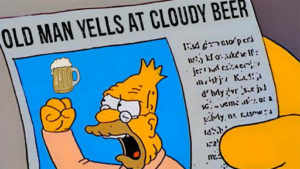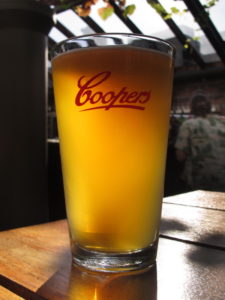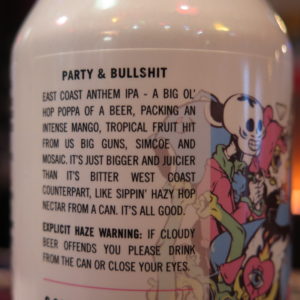
This piece first appeared in the August 2017 edition of SOBA’s magazine, The Pursuit of Hoppiness ― a thing which has evolved a lot recently and spawned a nicely-maintained online incarnation, among other improvements. I’ve seen that version of this post handed around a bit already, but I wanted to also share it here (as I have done with other pieces). Overtly hazy beers remain a hot-button topic (as you may already have noticed), but I think the whole thing is most useful as a microcosm for how we think about history and fashion and matters of taste overall…
As I sit down to write this, I’m finishing off a glass of some newfangled hazy beer from an “independent” brewery not far from here. It’s distinctly murky, which blunts its otherwise-lovely golden colour but it’s got a nice amount of flavour without too much bitterness. I could see myself getting used to it. “Sparkling Ale”, they call it. From a Coopers Brewery in Adelaide, founded as recently as 1862! That’s basically just yesterday, given that we humans have been making beer for some 7,0001 years…

My point, sarcastic but sincere, is that beer has a long history, filled with patterns and cycles and upheavals ― and one of the quickest ways to make a fool of yourself is to look at something changing or unfamiliar or new, lose all perspective, and freak out about it.
An excellent example of just that kind of misguided “outrage” can be found in a lot of the reaction to the rise of hazy East Coast (or “Vermont” or “New England”) style IPAs. Garage Project’s Party & Bullshit was the first notable local follower of the trend, which was expertly chronicled in this magazine’s Summer 2016 edition by Jono Galuszka. Revisit that piece for the style’s history and technical details ― I’m going to focus on the nonsense ways in which its detractors talked about how beer “should” be: how they freaked out about the haze, and how they dismissed it as a fad.
First, the murk. The idea that clarity is a mark of quality is incredibly recent, on any kind of sensible timescale. This is as true of beer as it is of cider or wine; all of them would’ve been significantly cloudy for a huge chunk of their histories. Crystal-clear beer depends on additives and equipment that doesn’t exactly grow on trees and weren’t just laying around for our ancestors to trip over. The techniques needed to make our drinks easy to see straight through had to be invented: there was a time before them, and they aren’t mandatory.

Before any of us had an East Coast IPA, we probably had a Belgian Wit, or a German Hefe2 ― or a Coopers Sparkling. There’s nothing “new” or “wrong” about those, is there? Relatively-clear beer has been dominant for a couple of hundred years, but never completely, and 200 years in this business, frankly, just isn’t that impressive or immediately meaningful. Given the long dominance of darker styles and opaque drinking vessels, if we wanted to figure out exactly when clarity become the norm, statistically and aesthetically, we’d need a time machine. I’d rather go see the dinosaurs.
With very few exceptions, haze is simply the side-effect of things done (or not done) for the sake of various flavours. In that way, it’s no different from the colour of beer, and I just can’t remember the last time anyone whinged about how “all beer should be gold”, or brown, or black. If you don’t like these beers because of their flavour of their texture, then (by all means) complain about those factors, not the haze that coincidentally results. But never, ever mistake your preferences for how things should be for everyone or anyone else.
You can see how shallow the “clear = quality” myth is by the fact that it’s capable of reversing completely. Not long ago, when Coopers Sparkling was the local paragon of “good beer”, Australian brewers got into the habit of fogging up their beers seemingly just to emulate it and borrow some of its prestige.3 Likewise, some brewers of juice-bomb East Coast IPAs exaggerate their haze with additives selected solely for that purpose, and not in pursuit of tastier beer as such. Such trickery is indeed obnoxious, but it’s the cheating, not the cloudiness, that offends me.

Second, the “fad” allegation. It’s simply nonsensical to claim that a particular turn in the long arc of beer history is less legitimate than any other. On a broader view of things, pilsner hasn’t yet proven itself: despite its current popularity, it’s only been around for about three percent of the time there’s been beer at all. For that matter, beer could just be a passing fancy, in human terms: our species has been here for 200,000 years but brewing for “merely” 7,000 or so. Of course, unless we get our act together, humanity itself might prove to only be a brief phase the planet was going through for a while…
The one constant is change. Something can seem carved in stone or built on sand, depending on the perspective you take. Everything that seem “normal” to us was new, and possibly scary once. If we diverted that time machine of ours, we wouldn’t have to travel back far to find people freaking out about other fads like fizz or hops ― as opposed to the gentler bubbles of “tradtional” carbonation, or “traditional” bittering ingredients like heather and bog myrtle.
There’s no “legit” IPA in a strong enough sense to render any variations from it somehow unworthy. Every attempt at making an “authentic”, historically-accurate version of something masks dozens of subconscious choices about which elements to replicate faithfully and which to ignore or update. Beer styles ― just like genres of music, film, art, or fiction ― evolve through a chaotic combination of gradual, accidental drift and intentional remix and reinvention. In our enjoyment of all our subjective endeavours and matters of taste, it’s normal to think less of things that emerged after we joined the scene; what was here when we arrived seems like the real deal, newcomers seems supicious. But just because it’s a natural impulse doesn’t mean it’s excusable. Don’t mistake a reflex for an insight. Don’t mistake “I don’t like this” for “it shouldn’t exist”.
- It said “4,000” in the magazine, which I think was more transcription error than editorial over-ride of the number itself ― which is obviously very ballpark-y, in any case. But the point stands.
- Well, probably. Unless you were isolated away from such things or are very new to beer and came into it at the crest of the juice-bomb phenomenon. But that’s just a nice thing to keep in mind, anyhow: the sequence of these things ― and therefore what is the control and what is the comparison ― for different people is as arbitrary as anything else. It’s like my favourite musing about the banana flavour in Hefe: Germans were almost certainly making those beers with those characters before the flavour-identical fruit was brought to Germany ― so somewhere, somewhen, there’s a generation who first ate a banana and thought “this tastes like wheat beer!”; the opposite of my experience.
- I learned this when I was at Garage Project, entering beers into a competition in Australia ― the paperwork required us to disclose whether we’d used ‘clouding agents’ (or some similar term), just as matter-of-factly as it was asking for the beer’s name and ABV. Of course, I’m happy to be corrected as to why such things were popular, but — call me cyncical (please) — I suspect I’m on the right track.
